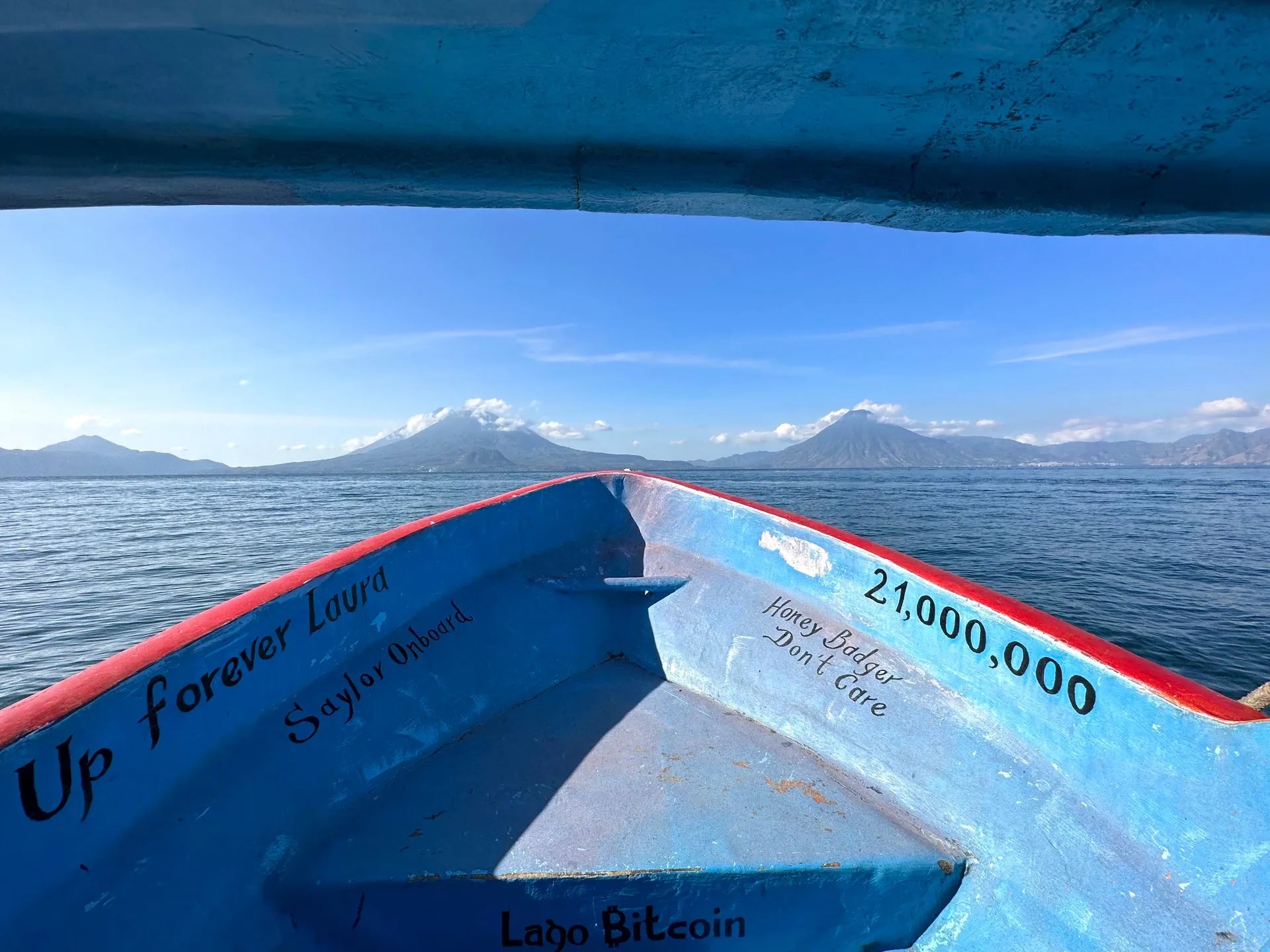Ever since we posted about our recent trip to Bitcoin Lake in Guatemala, we've gotten a lot of in-depth questions from plebs interested in visiting. If you're one of them, we might just have the answers you've been looking for.
For those who might have happened upon this post without reading Part 1 of this story, all you need to know is that Bitcoin Lake (officially Panajachel) is a grassroots Bitcoin circular economy that began to take shape in January 2022 and is now at 80 businesses in total, with a small yet ambitious ongoing mining operation and a school offering the Mi Primer Bitcoin Diploma to the local youth.
If that was enough to get you itching for a trip to Guatemala, read on to get some insights about the place and recommendations to start planning.

FAQs
Given all the questions we've been asked about our experience, we managed to group them into three categories: cost of living, safety, and weather. Here, we attempt to answer them as best as we can.
How expensive is Guatemala?
If you've ever been to Central America, you already know it's cheaper than North America and Europe. A tuk-tuk ride around town can cost you about $1; a good cup of coffee around $2; a meal at a local restaurant can easily cost you $2-3, while a touristy establishment might charge you around $8-14, depending on the type of cuisine.

As you may know by now, Panajachel is one of the multiple towns located around Lake Atitlàn. Therefore, boat taxis are the go-to mode of transportation in the area. A public boat ride from Pana to San Juan La Laguna, on the western side of the lake, is about $6 for a return ticket. Just remember to be punctual for your return trip (usually leaving at 5-5.30 pm), or else you'll have to hire a private boat to take you back, which will come at a much higher cost (about four times more).
For those who like to explore, local travel agencies offer a wide variety of day tours leaving from Pana, and they include experiences like seeing Mayan ruins, visiting chocolate factories and coffee plantations, hiking volcanos, and checking out cooperatives of anything from beekeepers to backstrap loom weavers. Costs vary, but they have a starting price of about $35.
Is Guatemala dangerous?
This is, without a doubt, the number one question we get whenever we talk about Guatemala (and even El Salvador). We always like to remind everyone that crime is everywhere, so letting that stop you from traveling to a new part of the world is silly.

Guatemala might have a bad rep for its high crime rate, but just like anywhere in the world, it's highly dependent on your choices. If you stick to hanging around touristy areas, use street-smart skills, and refrain from hanging out in odd places at odd hours, you'll likely have nothing to worry about.
We spent a week around Lake Atitlàn and even found ourselves walking back to our Airbnb in the dark (not past 9 pm, though), and we never felt unsafe.
Small towns come with small risks. The worst that could happen is encountering a pickpocket on a busy day at the market while you're distracted and walking around with your backpack half opened.
Just stay vigilant, keep your belongings close, and always remember to practice common sense.
What's the weather like in Guatemala?
The climate differs depending on where you find yourself in the country, given the differences in altitude and environment. The area around Lake Atitlàn is known as the place of 'eternal spring' given its mild climate throughout the year (average temperature of 65–75F or 19–25C). During the "winter months," it can get slightly chilly in the early mornings and evenings when the wind picks up, so a light sweater or jacket can come in handy.
And if humidity is not your friend, fear not, as the constant breeze from the lake keeps the air relatively dry and comfortable all day. So if sunny and comfortably warm weather is your thing (how could it not?), you're bound to enjoy Bitcoin Lake.
General Recommendations For Your Trip to Bitcoin Lake
So, you had a few concerns and needed some answers, and now that you've put all of them to rest, you're probably wondering exactly how to plan a trip there. In the following few paragraphs, we explain just that.

But before we dig into it, we wanted to give a massive shoutout to Eliazar, community leader, and Rudy, Mi Primer Bitcoin teacher, who made our experience ten times smoother than it would have been without their advice and help.
We highly suggest you start by DMing them with your questions and travel dates, as they can help you organize your trip and show you the key spots around town once you arrive.
How to Get to Bitcoin Lake
Lake Atitlàn is about 3 hours away from Guatemala City, the closest airport you can fly to. While there are new roads being built between the two locations, it's still a rather bumpy and winding road to get down to Panajachel.
Although there are public buses that can take you down to the lake for less than $10, it can take a long time given the numerous stops along the way, and it's not the most comfortable option given the tiny space and difficulty in communicating with the locals (unless you speak Spanish, of course). A safer and more convenient way would be a shared shuttle, which you have to book in advance and can cost about $40 per person.
The best way to do it, especially if you want to pay in Bitcoin, is to organize an airport pick-up with a private driver. Yes, it will cost you more ($50 per person), but at least you'll know you're in trustworthy hands and that you'll get dropped off at your exact destination.
Pro tip: if possible, avoid arriving on a Friday or Saturday, as the traffic can get crazy on those two days. It took us almost 6 hours to get to Pana on the Friday afternoon we arrived, and it was exhausting.
Where to Stay in Bitcoin Lake
Plebs looking to spend sats only (you have our respect!) can find options on the Blink App and the BTCMaps App. The number of hotels accepting Bitcoin is constantly growing, so you'll likely find more options than the ones we found just a few months ago.
If you want to live on a Bitcoin standard, we recommend staying in Panajachel. Other nearby towns are beginning to accept it too, but much less extensively, which could make it difficult for you to avoid using cash or (gasp) credit cards.
That said, if you want to disconnect from a busy environment with lots of traffic and prefer something more "earthy," we recommend San Marcos La Laguna. Known as the hippie town around the lake, it's the place to go if you're one to enjoy a more laidback lifestyle, vegan eats, permaculture workshops, yoga classes, raw chocolate, and anything related to mushrooms.
We spent two days there, and we had a lovely time. We certainly enjoyed the views from the Eagle's Nest cafe on top of a hill. Hard to say no to an epic landscape, chill vibes, and a fresh lemonade paid for in Bitcoin!
Conclusion
Bitcoin Lake is booming, and it's bound to become one of bitcoiners' favorite citadels in the world. If you're considering a visit, this is the time to do it. Pack your bags, load up your lightning wallet, and contribute to a true Bitcoin circular economy in a different part of the world. You will not regret it!

